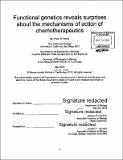| dc.contributor.advisor | Michael T. Hemann. | en_US |
| dc.contributor.author | Bruno, Peter M. (Peter Michael) | en_US |
| dc.contributor.other | Massachusetts Institute of Technology. Department of Biology. | en_US |
| dc.date.accessioned | 2016-09-13T19:08:20Z | |
| dc.date.available | 2016-09-13T19:08:20Z | |
| dc.date.copyright | 2016 | en_US |
| dc.date.issued | 2016 | en_US |
| dc.identifier.uri | http://hdl.handle.net/1721.1/104171 | |
| dc.description | Thesis: Ph. D., Massachusetts Institute of Technology, Department of Biology, 2016. | en_US |
| dc.description | Cataloged from PDF version of thesis. | en_US |
| dc.description | Includes bibliographical references (pages 186-218). | en_US |
| dc.description.abstract | Chemotherapy for the treatment of systemic cancer originated over half a century ago. Thus, many of our most successful therapies were implemented clinically without the wealth of molecular and genetic knowledge we have today. Other than empirically determined survival benefit, another primary consideration of drug use was based on combinations of drugs with non-overlapping toxicity; that way patients could withstand more chemotherapy without succumbing to the side effects. Additionally, new drugs were developed with an eye largely toward reducing toxicity, while assuming minor structural modifications would not affect the primary cytotoxic mechanism of action. However, relatively little effort has been devoted to reexamining how and why these early therapies are successful in some cancers and not others, or for some patients and not others. Here, I used functional genetics to examine the mechanisms of action of new and emerging anti-cancer agents. First, the platinum-based chemotherapeutics, cisplatin and its analogues, carboplatin and oxaliplatin, were evaluated. Previously all platinum anti-cancer agents were assumed to kill cells via DNA cross-linking. However, using an RNAi-based drug mechanism of action predictive signature, we were able to determine that oxaliplatin instead exerts its cytotoxicity via inhibition of transcription/translation, not the canonical DNA crosslinking mechanism of action exhibited by cisplatin and carboplatin. This finding predicts new clinical uses for oxaliplatin and suggests that conventional chemotherapy can be thought of in a more targeted manner. Functional genetics was further used to gain novel insights into emerging anti-cancer agents and delivery modalities. Nanoparticles are a new method of chemotherapy delivery that have the ability to reduce toxicity and enhance tumor specific drug delivery. Surprisingly, we found that the process of creating nanoparticles can fundamentally alter the mechanism of action of the delivered drug. Additionally, the RNAi-based drug mechanism of action signatures were used to optimize nanoparticles to deliver combinations of drugs. Furthermore, the recently developed anti-cancer compound, CX-5461, was discovered to inhibit Topoisomerase 2 as its primary mechanism of action, instead of the previously assumed RNA polymerase I inhibition. Finally, new functional genetic tools were developed for examining tumor progression and therapeutic response both in vitro and in vivo. These new technologies, known as CRISPRi and CRISPRa, were demonstrated to easily and efficiently facilitate screening of genes influencing tumor growth and treatment relapse. Thus, future utilization of these tools should permit faster discovery and translation of new findings to the clinic. | en_US |
| dc.description.statementofresponsibility | by Peter M. Bruno. | en_US |
| dc.format.extent | 218 pages | en_US |
| dc.language.iso | eng | en_US |
| dc.publisher | Massachusetts Institute of Technology | en_US |
| dc.rights | M.I.T. theses are protected by copyright. They may be viewed from this source for any purpose, but reproduction or distribution in any format is prohibited without written permission. See provided URL for inquiries about permission. | en_US |
| dc.rights.uri | http://dspace.mit.edu/handle/1721.1/7582 | en_US |
| dc.subject | Biology. | en_US |
| dc.title | Functional genetics reveals surprises about the mechanisms of action of chemotherapeutics | en_US |
| dc.type | Thesis | en_US |
| dc.description.degree | Ph. D. | en_US |
| dc.contributor.department | Massachusetts Institute of Technology. Department of Biology | |
| dc.identifier.oclc | 958133202 | en_US |
